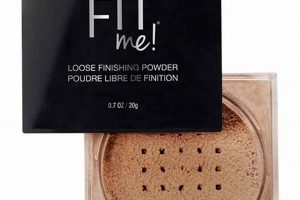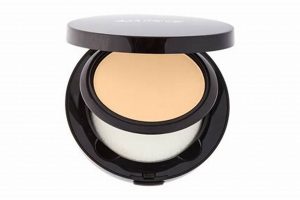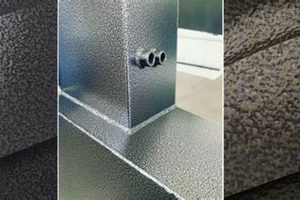A finely milled cosmetic product, typically composed of ingredients such as talc, silica, or cornstarch, is designed to be applied after foundation and concealer. Its primary function is to set makeup, reducing shine and creating a smoother, more even complexion. For instance, after applying liquid foundation, a light dusting of this product with a brush or sponge can help prevent creasing and prolong the wear of the makeup.
This type of product offers multiple advantages. It aids in oil absorption, which is particularly beneficial for individuals with oily or combination skin. It can also blur imperfections, minimizing the appearance of pores and fine lines. Furthermore, its use extends the longevity of the underlying makeup application, reducing the need for frequent touch-ups. Historically, similar formulations have been used for centuries to achieve a refined and polished appearance.
The subsequent discussion will delve into various application techniques, ingredient considerations, and selection criteria for achieving optimal results with this cosmetic staple. The different types available, and how to choose the right shade for specific skin tones will also be covered.
Application Guidelines
The following guidelines aim to optimize the use of the cosmetic item for enhanced makeup performance and a refined appearance.
Tip 1: Brush Selection. Employ a large, fluffy brush with soft bristles. This ensures even product distribution and prevents a heavy, cakey finish. A densely packed brush can deposit too much product, resulting in an unnatural look.
Tip 2: Light Application. Use a light hand when applying. Tap the brush to remove excess powder before application to the face. This minimizes the risk of over-application and prevents a dusty appearance.
Tip 3: Targeted Application. Focus application on areas prone to shine, such as the forehead, nose, and chin (T-zone). This controls oil production and maintains a matte finish throughout the day.
Tip 4: Patting Technique. Consider using a patting or pressing motion with a makeup sponge or puff in areas needing extra coverage or oil control. This helps to press the product into the skin for better adherence and longevity.
Tip 5: Baking Method. For extended wear, the “baking” technique can be employed. Apply a generous layer to areas like under the eyes, allow it to “bake” for several minutes, and then dust away the excess. This creates a crease-proof and brightened effect.
Tip 6: Avoid Over-Application. Excessive use can emphasize fine lines and wrinkles. Apply in thin layers, building up coverage only where necessary. Regular assessment in natural lighting is crucial to prevent over-application.
Tip 7: Setting Sprays. Integrate a setting spray after application to meld the product with the skin. This helps to eliminate any powdery residue and enhances the overall finish of the makeup.
Adhering to these guidelines promotes a flawless complexion, reduces shine, and extends the longevity of makeup, resulting in a polished and professional look.
The subsequent section will address troubleshooting common issues and address frequently asked questions about this specific product.
1. Texture
The texture of milled powder directly influences its performance and aesthetic outcome. A finely milled powder, characterized by microscopic particle size, facilitates even distribution across the skin’s surface. This attribute prevents clumping and ensures a seamless blend with underlying makeup. Conversely, a coarser texture can result in a patchy appearance, emphasizing skin imperfections such as enlarged pores or fine lines. For instance, a product composed of large, irregular particles may settle unevenly, creating a visible, unnatural finish. The selection of appropriate particle size is therefore critical to achieving a smooth, refined complexion.
Variations in texture also affect oil absorption capabilities. Powders with a finer consistency often exhibit superior oil control, making them suitable for individuals with oily or combination skin types. The increased surface area provided by smaller particles enhances their ability to absorb excess sebum, maintaining a matte finish for an extended period. Furthermore, texture plays a role in the product’s ability to minimize the appearance of pores. A finely milled product can effectively blur pores by filling them in without creating a heavy or cakey effect. The practical implication is that a well-textured product reduces the need for frequent touch-ups and minimizes the risk of makeup breakdown due to excess oil.
In summary, texture represents a fundamental characteristic that dictates both the aesthetic quality and the functional performance of the product. A finely milled, uniform texture is essential for achieving a smooth, matte finish, minimizing the appearance of imperfections, and extending the wear of makeup. Challenges remain in formulating products that maintain a consistently fine texture across diverse skin types and environmental conditions. Optimizing this parameter is crucial for delivering a high-quality cosmetic experience.
2. Ingredients
The composition of milled powder formulations is paramount, directly influencing product performance, skin compatibility, and overall aesthetic outcome. Understanding the properties of common ingredients is crucial for informed product selection and effective use.
- Talc
Hydrated magnesium silicate, widely used for its soft texture and oil-absorbing properties. Its use has been subject to scrutiny due to potential asbestos contamination; therefore, sourcing from reputable suppliers is essential. In the context of milled powder, talc contributes to a smooth finish and helps control shine. However, it may cause dryness in some individuals.
- Silica
A naturally occurring compound derived from sand or quartz, known for its excellent oil-absorbing capabilities and light-diffusing properties. It is often incorporated to provide a matte finish and minimize the appearance of pores and fine lines. Unlike talc, silica is generally considered non-comedogenic and less likely to cause dryness, making it a preferable option for some skin types.
- Mica
A mineral that imparts a subtle shimmer and luminosity to the product. Its light-reflecting properties contribute to a more radiant complexion, preventing a flat or dull appearance. The particle size of mica can vary; finer particles provide a subtle glow, while larger particles create a more noticeable shimmer. The concentration of mica must be carefully controlled to avoid an overly sparkly effect.
- Starch (e.g., Cornstarch, Rice Starch)
A natural alternative to talc, offering oil absorption and a soft texture. Starch-based formulas are often preferred by individuals seeking natural or organic cosmetic options. However, starch may be more prone to clumping or caking than talc, especially in humid environments. Proper formulation techniques are required to mitigate these potential drawbacks.
The selection and proportion of these components, alongside preservatives and colorants, define the functionality and safety profile of the cosmetic item. Knowledge of these components enables consumers to make informed choices based on their individual skin needs and preferences, ultimately enhancing the performance and satisfaction derived from this specific beauty staple.
3. Shade Matching
Achieving a seamless complexion through the application of loose finishing powder is inextricably linked to accurate shade matching. An inappropriate shade can negate the intended benefits of the product, resulting in an undesirable cosmetic outcome. This aspect warrants careful consideration to ensure a natural and harmonious integration with the underlying skin tone.
- Undertone Compatibility
The undertone of the product must align with the individual’s skin undertone (warm, cool, or neutral). Mismatched undertones can lead to an ashen or ruddy appearance. For instance, applying a cool-toned product to warm skin may create a gray cast, while a warm-toned product on cool skin may appear overly orange. Identifying and matching undertones is thus paramount for achieving a natural finish.
- Translucent vs. Tinted Formulations
Translucent formulations are designed to be colorless and suitable for a broad range of skin tones. However, they can sometimes create a white cast on deeper complexions, particularly in photographs with flash. Tinted formulations offer a color range that more closely corresponds to specific skin tones, minimizing the risk of a white cast. Careful consideration of the formulation type is essential based on skin depth and photographic considerations.
- Oxidation Effects
Some products may oxidize upon contact with the skin, resulting in a change in color intensity. This oxidation can cause the product to appear darker or more orange over time. Testing the product on a small area of the skin and observing it under natural lighting for several hours can help predict oxidation effects and ensure an accurate shade match.
- Seasonal Variations
Skin tone may fluctuate throughout the year due to sun exposure or changes in skincare routines. Adjusting the shade of the loose finishing powder to accommodate these seasonal variations is crucial for maintaining a seamless complexion. Using a slightly darker shade during the summer months and a lighter shade during the winter months can ensure a consistent and natural appearance.
These facets highlight the intricate relationship between shade matching and the effective utilization of loose finishing powder. Accurate shade selection, accounting for undertones, formulation type, oxidation, and seasonal changes, is integral to achieving a flawless and natural-looking finish. Failure to adequately address these considerations can compromise the intended aesthetic benefits of this product.
4. Application
The method of application profoundly influences the efficacy and aesthetic outcome achieved with milled powder. Proper technique optimizes product performance, minimizes potential drawbacks, and contributes to a refined complexion. Inadequate application can result in uneven coverage, a cakey texture, or an undesirable white cast.
- Tool Selection and Technique
The choice of application tool significantly impacts the final result. A large, fluffy brush facilitates even product distribution, preventing localized buildup. Conversely, a densely packed brush deposits more product, potentially leading to a heavy appearance. The use of a damp sponge or puff can provide targeted coverage and press the product into the skin for increased longevity. Employing the correct tool and technique is essential for achieving a seamless and natural finish.
- Product Quantity Control
Excessive application of milled powder can accentuate fine lines and wrinkles, creating an aged or unnatural look. Applying the product in thin, buildable layers allows for controlled coverage and prevents over-application. Tapping off excess powder from the brush before application is crucial to minimize the risk of a cakey or dusty appearance. Judicious product quantity control is paramount for achieving a refined and youthful complexion.
- Targeted Placement
Strategic placement of milled powder is key to addressing specific concerns, such as oil control and minimizing pore visibility. Focusing application on areas prone to shine, such as the T-zone, helps maintain a matte finish throughout the day. Applying a small amount to the under-eye area can set concealer and prevent creasing. Targeted placement allows for customized application based on individual skin needs, maximizing product benefits.
- Buffing and Blending
Proper buffing and blending are essential for seamlessly integrating the product with the skin. Gentle circular motions with a brush or sponge help to diffuse the product and eliminate any harsh lines or demarcation. Adequate blending ensures a natural-looking finish and prevents the product from sitting on top of the skin. Careful buffing and blending are necessary for achieving a flawless and airbrushed effect.
These components underscore the critical role of application technique in maximizing the benefits of milled powder. Skillful application, encompassing tool selection, product quantity control, targeted placement, and thorough blending, is indispensable for achieving a refined complexion, extending makeup wear, and enhancing overall aesthetic appeal.
5. Longevity
Longevity, in the context of milled powder, refers to the duration for which the product maintains its intended effects, primarily minimizing shine and setting makeup. The inherent oil-absorbing properties and formulation stability directly influence this duration. A product exhibiting inadequate oil control necessitates frequent reapplication, diminishing its practical value. Factors affecting the temporal efficacy include the composition of the powder, the individual’s skin type and activity level, and the ambient environmental conditions. For instance, a formulation heavily reliant on talc may exhibit reduced longevity on individuals with excessively oily skin compared to a silica-based counterpart. Similarly, high humidity levels can compromise the product’s ability to control shine, thereby reducing its effective lifespan on the skin.
The product’s capacity to prolong the wear of underlying makeup constitutes a crucial aspect of longevity. A high-performing product will prevent foundation and concealer from creasing, fading, or transferring for an extended period. This attribute is particularly important in professional settings, such as photography or television, where makeup integrity is paramount. Consider a scenario where a makeup artist applies a full face of makeup for a twelve-hour film shoot. The effectiveness of the milled powder in maintaining the makeup’s initial appearance directly impacts the need for touch-ups and the overall quality of the final production. Conversely, a product with poor longevity requires constant attention and can lead to inconsistencies in the makeup’s appearance throughout the day.
The interplay between composition, application technique, and environmental factors dictates the overall longevity of the product’s effects. Understanding these interactions is crucial for selecting a product that aligns with individual needs and environmental conditions. While advancements in formulation technology have enhanced the longevity of many available products, challenges remain in formulating powders that can effectively withstand extreme conditions or accommodate diverse skin types. Optimizing longevity remains a central objective for cosmetic chemists and a key consideration for consumers seeking reliable and long-lasting makeup performance.
Frequently Asked Questions
The following addresses prevalent inquiries concerning the correct usage and optimal application of the cosmetic item.
Question 1: Is milled powder suitable for all skin types?
The suitability of loose finishing powder varies depending on individual skin characteristics. Individuals with dry skin may find that certain formulations exacerbate dryness, while those with oily skin typically benefit from its oil-absorbing properties. Selection of a formulation tailored to one’s specific skin type is crucial.
Question 2: Can milled powder cause breakouts?
Some milled powders contain ingredients that may be comedogenic, potentially leading to breakouts in susceptible individuals. Prior examination of the ingredient list and selection of non-comedogenic formulations are advised to minimize the risk of acne formation.
Question 3: How does milled powder differ from pressed powder?
Milled powder, as its name suggests, is a loose, finely ground product, while pressed powder is compacted into a solid form. Milled powder generally provides a lighter, more diffused finish, whereas pressed powder offers greater coverage and portability.
Question 4: Should milled powder be applied before or after blush?
Milled powder is typically applied after the application of cream or liquid products, including foundation, concealer, and cream blush. This sets the base and creates a smooth canvas for subsequent powder products, such as powder blush or bronzer.
Question 5: Can milled powder be used without foundation?
Milled powder can be used independently of foundation to control shine and even out skin tone, particularly for individuals seeking a minimal makeup look. However, it provides limited coverage compared to foundation and is primarily intended for setting makeup and reducing oiliness.
Question 6: How can a white cast be avoided when using milled powder?
A white cast, often observed in photographs with flash, can be avoided by selecting a tinted formulation that closely matches the skin tone. Alternatively, using a light hand during application and thoroughly blending the product can minimize the risk of a white cast.
The aforementioned questions and answers offer clarification on key aspects regarding the use of loose finishing powder. Informed application and product selection remain critical for achieving optimal results.
The subsequent section will provide a comparative analysis of available brands and formulations, assisting consumers in making informed purchasing decisions.
Conclusion
This exposition has systematically examined key facets of loose finishing powder, encompassing texture, ingredients, shade matching, application techniques, and longevity. An understanding of these factors facilitates informed decision-making, enabling users to optimize product performance and achieve desired aesthetic outcomes. The selection of appropriate formulations, coupled with proper application, remains paramount for realizing the intended benefits of this cosmetic staple.
Continued advancements in formulation technology and application methodologies will likely refine the capabilities of this product. It is incumbent upon consumers and professionals alike to remain informed regarding these developments, ensuring optimal utilization and promoting both aesthetic enhancement and skin health. Further research into ingredient safety and compatibility remains essential for safeguarding consumer well-being.







